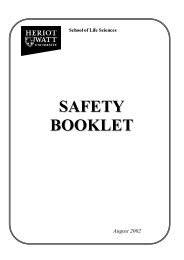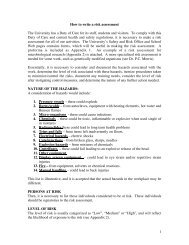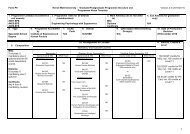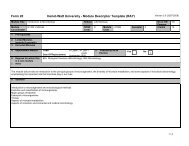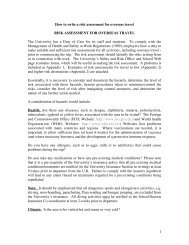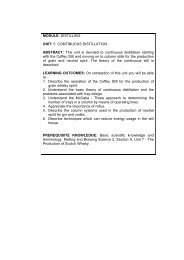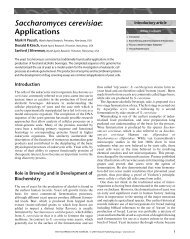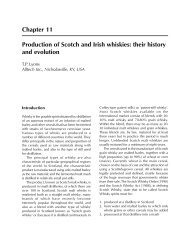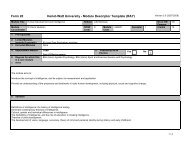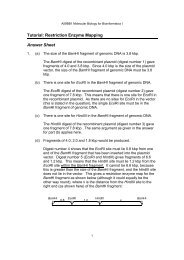Big Five Factors of Personality and Replicated Predictions of Behavior
Big Five Factors of Personality and Replicated Predictions of Behavior
Big Five Factors of Personality and Replicated Predictions of Behavior
You also want an ePaper? Increase the reach of your titles
YUMPU automatically turns print PDFs into web optimized ePapers that Google loves.
BIG FIVE PREDICTORS<br />
421<br />
probably multifaceted <strong>and</strong> multidetermined. This is to imply that<br />
<strong>Big</strong> <strong>Five</strong> personality factors are not the only variables involved in<br />
the determination <strong>of</strong> complex criteria such as grade point average,<br />
alcohol consumption, or tendency to engage in dieting behavior.<br />
Surely such behaviors have multiple causes, including genetic<br />
predispositions, hormonal influences, various environmental determinants,<br />
<strong>and</strong> their interactions. <strong>Personality</strong> may, in fact, have<br />
only a minor influence on the behaviors evaluated in this research.<br />
The empirical factor–criterion correlations would be expected to<br />
improve to the extent that other relevant predictors are included in<br />
the analyses.<br />
A third reason why the correlations in this study are probably<br />
attenuated concerns the personality predictors themselves. Data<br />
have been presented elsewhere showing that, although the <strong>Big</strong> <strong>Five</strong><br />
factors <strong>of</strong> personality have some utility in predicting criterion<br />
behaviors <strong>of</strong> the type studied here, the constituent facets <strong>of</strong> those<br />
factors can do better in that regard (e.g., Ashton, 1998; Ashton et<br />
al., 1995; Mershon & Gorsuch, 1988; Paunonen, 1993, 1998;<br />
Paunonen et al., 1999; Paunonen & Ashton, 2001a, 2001b;<br />
Paunonen & Nicol, 2001; Rothstein et al., 1994). Consider the<br />
example <strong>of</strong> low Conscientiousness predicting alcohol consumption<br />
shown in Table 3. This (replicated) empirical finding might not<br />
make theoretical sense at first glance. However, Conscientiousness<br />
is a factor <strong>of</strong> personality that represents several distinct but correlated<br />
personality traits or facets. These facets purportedly include<br />
orderliness, achievement orientation, <strong>and</strong> self-discipline, among<br />
others. The aforementioned negative correlation could thus be<br />
entirely due to an inverse association between self-discipline <strong>and</strong><br />
alcohol consumption. It might have absolutely nothing to do with<br />
orderliness, achievement orientation, or any other facet <strong>of</strong> that<br />
factor. Consequently, combining several relatively narrow Conscientiousness<br />
facets together into a single indicator <strong>of</strong> that broad<br />
personality factor could actually lead to a lower coefficient <strong>of</strong><br />
prediction than would be obtained if the individual facets were<br />
treated as separate predictors.<br />
There is yet another reason for the seemingly low coefficients <strong>of</strong><br />
correlation reported between the present personality variables <strong>and</strong><br />
behavior criteria. There may be other variables, personality variables,<br />
that might be implicated in the prediction <strong>of</strong> the behaviors<br />
but that were not included in this study. I refer not to the facets <strong>of</strong><br />
the <strong>Big</strong> <strong>Five</strong> personality factors mentioned in the preceding paragraph<br />
but to other lower level personality traits that do not fit well<br />
into the five-factor model <strong>of</strong> personality structure <strong>and</strong>, hence, are<br />
not incorporated as components <strong>of</strong> typical <strong>Big</strong> <strong>Five</strong> factor measures.<br />
I have studied such variables (Paunonen & Jackson, 2000)<br />
<strong>and</strong> concluded that there might be several well-defined personality<br />
traits that exist beyond the <strong>Big</strong> <strong>Five</strong> factors (cf. Saucier & Goldberg,<br />
1998). Honesty is one possible example <strong>of</strong> such a dimension<br />
(see also Ashton, Lee, & Son, 2000). Including a measure <strong>of</strong><br />
honesty in the present study might have increased the prediction <strong>of</strong><br />
some <strong>of</strong> the behavior criteria, such as number <strong>of</strong> traffic violations,<br />
for instance. Other non-<strong>Big</strong> <strong>Five</strong> variables might have served as<br />
useful predictors <strong>of</strong> other criteria.<br />
There are many reasons why the present levels <strong>of</strong> factor–<br />
criterion correlation might be as high as can be expected under the<br />
circumstances. Changing those circumstances could readily lead to<br />
nontrivial improvements in the accuracies <strong>of</strong> behavior predictions.<br />
Adding different personality variables into the predictor set would<br />
be an easy first step. Less easy would be the identification <strong>and</strong><br />
assessment <strong>of</strong> relevant nonpersonality determinants <strong>of</strong> behavior,<br />
such as genetic factors, environmental influences, <strong>and</strong> their<br />
interplay.<br />
Conclusions<br />
The present results are interpreted as supporting the following<br />
conclusions. The <strong>Big</strong> <strong>Five</strong> factor inventories used in this study<br />
show a strong convergence in their measurements <strong>and</strong> predictions.<br />
That consistency <strong>of</strong> results supports the construct validity <strong>of</strong> those<br />
inventories. Furthermore, the replicated behavior predictions<br />
found in this research strongly implicate specific personality constructs<br />
as underlying determinants <strong>of</strong> specific complex behaviors.<br />
That conclusion notwithst<strong>and</strong>ing, it is argued that even better<br />
empirical predictions can be achieved if other variables are included<br />
in the battery <strong>of</strong> behavior predictors, leading to an even<br />
better underst<strong>and</strong>ing <strong>of</strong> the nomological network <strong>of</strong> behavior determinants.<br />
Those other variables might include (a) the narrow<br />
personality facets that constitute the broad <strong>Big</strong> <strong>Five</strong> factors, (b)<br />
personality traits that are largely independent <strong>of</strong> the <strong>Big</strong> <strong>Five</strong>, <strong>and</strong><br />
(c) other determinants <strong>of</strong> behavior related to genetics <strong>and</strong> the<br />
environment.<br />
References<br />
Allik, J., & Realo, A. (1997). Intelligence, academic abilities, <strong>and</strong> personality.<br />
<strong>Personality</strong> <strong>and</strong> Individual Differences, 23, 809–814.<br />
Ashton, M. C. (1998). <strong>Personality</strong> <strong>and</strong> job performance: The importance <strong>of</strong><br />
narrow traits. Journal <strong>of</strong> Organizational <strong>Behavior</strong>, 19, 289–303.<br />
Ashton, M. C., Jackson, D. N., Paunonen, S. V., Helmes, E., & Rothstein,<br />
M. G. (1995). The criterion validity <strong>of</strong> broad factor scales versus specific<br />
trait scales. Journal <strong>of</strong> Research in <strong>Personality</strong>, 29, 432–442.<br />
Ashton, M. C., Lee, K., & Son, C. (2000). Honesty as the sixth factor <strong>of</strong><br />
personality: Correlations with Machiavellianism, primary psychopathy,<br />
<strong>and</strong> social adroitness. European Journal <strong>of</strong> <strong>Personality</strong>, 14, 359–368.<br />
Barrick, M. R., & Mount, M. K. (1991). The <strong>Big</strong> <strong>Five</strong> personality dimensions<br />
<strong>and</strong> job performance: A meta-analysis. Personnel Psychology, 44,<br />
1–26.<br />
Cohen, J. (1988). Statistical power analysis for the behavioral sciences.<br />
Hillsdale, NJ: Erlbaum.<br />
Costa, P. T., Jr., & McCrae, R. R. (1992). Revised NEO <strong>Personality</strong><br />
Inventory (NEO–PI–R) <strong>and</strong> NEO <strong>Five</strong>-Factor Inventory (NEO–FFI)<br />
pr<strong>of</strong>essional manual. Odessa, FL: Psychological Assessment Resources,<br />
Inc.<br />
De Raad, B., & Perugini, M. (Eds.). (2002). <strong>Big</strong> <strong>Five</strong> assessment. Göttingen,<br />
Germany: Hogrefe & Huber.<br />
Digman, J. M. (1990). <strong>Personality</strong> structure: Emergence <strong>of</strong> the <strong>Five</strong>-Factor<br />
Model. Annual Review <strong>of</strong> Psychology, 41, 417–440.<br />
Funder, D. C. (2001). <strong>Personality</strong>. Annual Review <strong>of</strong> Psychology, 52,<br />
197–221.<br />
G<strong>of</strong>f, M., & Ackerman, P. L. (1992). <strong>Personality</strong>–intelligence relations:<br />
Assessment <strong>of</strong> typical intellectual engagement. Journal <strong>of</strong> Educational<br />
Psychology, 84, 537–552.<br />
Hough, L. M. (1992). The “<strong>Big</strong> <strong>Five</strong>” personality variables–construct<br />
confusion: Description versus prediction. Human Performance, 5, 139–<br />
155.<br />
Jackson, D. N. (1984). <strong>Personality</strong> Research Form manual. Port Huron,<br />
MI: Research Psychologists Press.<br />
Lord, F. M., & Novick, M. R. (1968). Statistical theories <strong>of</strong> mental test<br />
scores. Menlo Park, CA: Addison-Wesley.<br />
McCrae, R. R., & John, O. P. (1992). An introduction to the <strong>Five</strong>-Factor<br />
Model <strong>and</strong> its applications. Journal <strong>of</strong> <strong>Personality</strong>, 60, 175–215.



